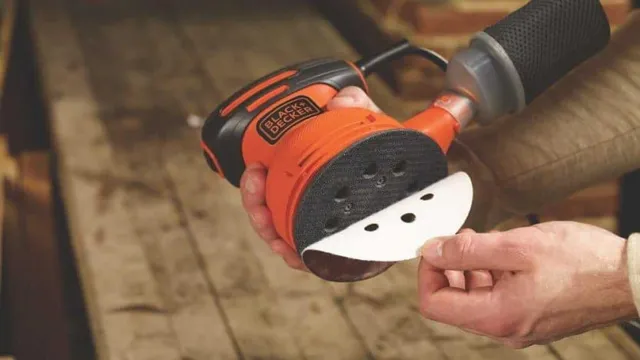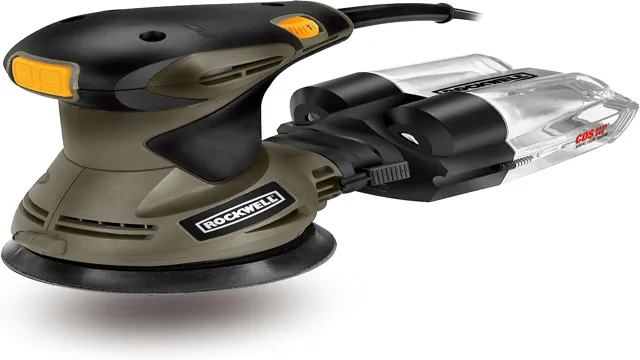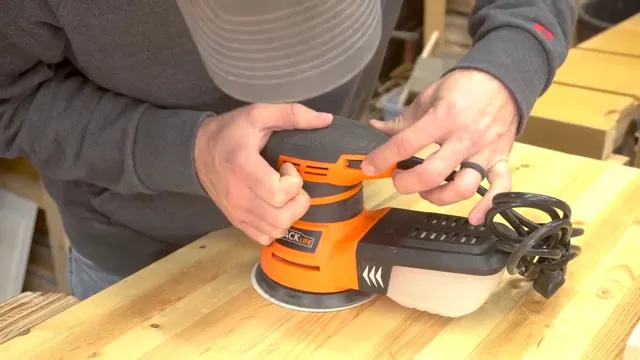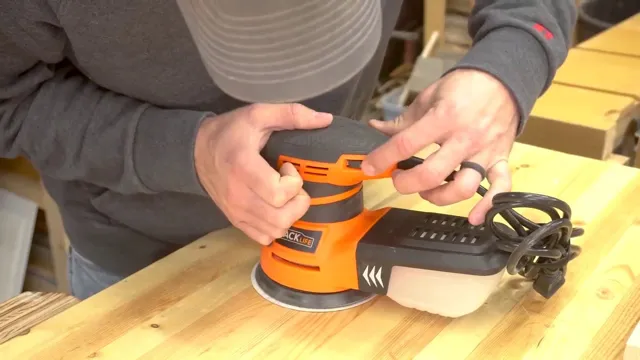What Does a Orbital Sander Do – A Comprehensive Guide to Its Uses and Benefits
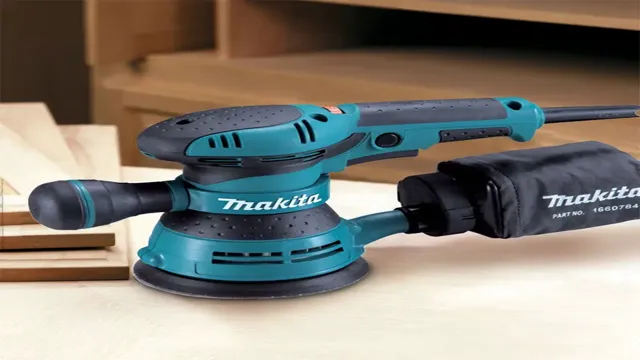
If you’re a woodworking enthusiast or a DIY hobbyist, you’ve probably heard of orbital sanders. But do you know what they are and how they work? An orbital sander is a power tool that is used to smooth and sand surfaces of wood, metal, and other materials with great precision and speed. It’s a versatile tool that is essential in any woodworking shop or garage, and it can save you a lot of time and effort compared to sanding by hand.
An orbital sander rotates and oscillates in random orbits, which means that it doesn’t leave any swirl marks on the surface and produces a smooth, consistent finish. Whether you’re refinishing furniture, sanding wooden floors, or working on a DIY project, an orbital sander is a must-have tool that can improve the quality and efficiency of your work. In this blog post, we’ll explore the different types of orbital sanders, their features, and how to choose the right one for your needs.
So grab a cup of coffee and let’s dive in!
Definition
An orbital sander is a versatile tool that is commonly used in woodworking. It is a handheld power tool that operates by spinning a sanding disk in a circular motion. This motion allows for the sander to smooth out rough surfaces and remove the old finish in preparation for refinishing.
The sander’s small size and maneuverability make it an ideal tool for reaching tight spaces and corners that other sanders can’t reach. Additionally, the sander’s random orbit motion helps to prevent swirl marks from appearing on the surface being sanded. In short, an orbital sander is a fantastic tool for anyone who wants to achieve a smooth, even finish on their woodworking project without much effort.
Explanation of an Orbital Sander
An orbital sander is a power tool that is used to smooth surfaces, mainly wood and plastic, by sanding them in a circular motion. It is called an “orbital” sander because of the circular motion that it makes. The sander uses sandpaper, which is attached to the sanding pad using a hook-and-loop system.
The sandpaper grit varies depending on the level of roughness required for the surface being sanded. The orbital sander has a motor that powers the sanding pad to revolve, which makes it easier to sand large areas. It is a versatile tool that can be used for a range of tasks, including removing paint, smoothing wood, and preparing surfaces for further finishing.
The compact and lightweight design of the orbital sander also makes it easy to use for extended periods without feeling fatigued. Overall, an orbital sander is a useful tool for anyone who wants to achieve a smooth and flawless finish on their woodworking or plastic projects.
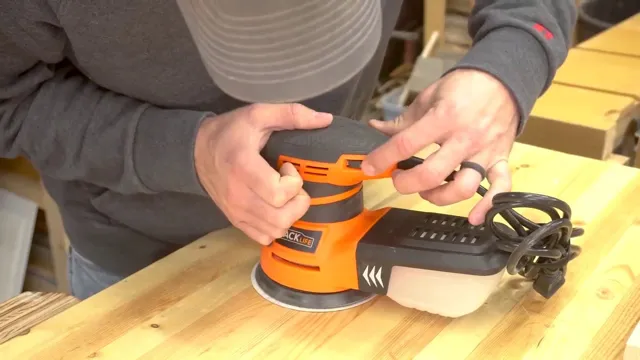
Types
If you want a sander that can sand surfaces smooth, a random orbital sander is a great tool to use. A random orbital sander is a unique type of sander that uses round sandpaper discs, which spin and move in a random pattern to prevent swirls or scratches. It is perfect for sanding wood, metal, or plastic surfaces, as well as removing old paint or finishes.
The best part about a random orbital sander is that it can work on curved or contoured surfaces with ease, making it a valuable tool for any DIY project enthusiast. So, if you are wondering “what does an orbital sander do?” It helps you sand down various types of materials and surfaces while delivering a smooth, flawless finish that will leave your projects looking their best.
Palm Orbital Sander
When it comes to palm orbital sanders, there are two main types to consider: corded and cordless. Corded sanders provide a constant source of power, making them ideal for larger projects that require extended use. On the other hand, cordless sanders allow for greater mobility and flexibility, as they can be used anywhere without the need for a power outlet.
Both types of sanders are effective at removing material from various surfaces, but it ultimately comes down to personal preference and the specific project at hand. So whether you need a sander for a big job or a quick touch-up, there’s a palm orbital sander out there that can meet your needs.
Random-Orbit Sander
When it comes to sanding, random-orbit sanders are an essential tool to get the task done with precision and speed. There are two main types of random-orbit sanders: corded and cordless. Corded sanders are powerful and allow for continuous use, regardless of the job size.
However, they require a nearby power source and can become cumbersome when navigating corners or tight spaces. On the other hand, cordless sanders offer greater mobility and maneuverability. They are quickly becoming a popular option, especially with the advancements in battery technology, allowing for similarly powerful performance to corded models.
Ultimately, the type of random-orbit sander you choose will depend on the job at hand and personal preferences. Make sure to consider the pros and cons of each before making your purchase.
Sheet Sander
When it comes to sheet sanders, there are a few different types to choose from depending on your specific needs. The most common type is the palm-grip sander, which is designed to be held in one hand and is great for smaller sanding projects. Another type is the orbital sander, which is larger and has a square sanding pad that moves in a circular motion.
This type of sander is great for larger projects that require a lot of sanding. Then there’s the belt sander, which is designed for heavy-duty sanding and can be used for removing paint, smoothing rough surfaces, and more. No matter which type you choose, it’s important to consider factors such as power, speed, and dust collection to ensure that you select the right tool for your needs.
By doing so, you’ll be able to achieve smooth and even surfaces in no time.
Uses
If you’re planning to carry out a DIY project or even professional woodworking, an orbital sander can be a handy and effective tool for smoothing and polishing surfaces. So, what does an orbital sander do? Well, an orbital sander rotates a sanding disk in small elliptical orbits, which creates an almost scratch-free finish while removing the old paint or varnish. It’s a versatile sander that allows you to adjust the speed and the type of sandpaper needed for the job at hand.
It’s ideal for sanding large pieces of wood, such as doors or tables, as it can cover large areas quickly and with precision. Orbital sanders can also be used on curved and rounded surfaces, such as chair rails or crown molding. They’re relatively easy to use, reduce fatigue, and can save a lot of time compared to sanding by hand.
Overall, an orbital sander is an incredibly useful tool in any DIY enthusiast or professional carpenter’s toolkit.
Smoothing Wood Surfaces
Smoothing wood surfaces is a crucial process that is essential for achieving a high-quality finish on any woodworking project. Whether you are building a piece of furniture, cabinetry, or working on any other woodworking project, smoothing the wood surfaces is something that should not be overlooked. It is a technique that is used to remove any rough areas, splinters, and other imperfections on the wood surface, ensuring that the wood surface is smooth and even.
This not only enhances the appearance of the final product, but it also makes the wood surface more durable and adds to its longevity. Smoothing wood surfaces can be achieved using various tools including sandpaper, a hand plane, or a power sander. All of these options make the process very easy and efficient, allowing you to achieve the quality finish that your woodworking project deserves.
Removing Paint and Varnish
Removing paint and varnish can be a daunting task, but it’s a necessary one if you want to improve the appearance of your home. The uses of paint and varnish removers are many, from prepping surfaces for new paint to restoring old furniture. These products work by breaking down the chemical bonds that hold the paint or varnish to the surface, allowing it to be easily scraped or wiped away.
One advantage of using a paint or varnish remover is that it is less damaging to the surface underneath than sanding. Additionally, it can save you time and effort by eliminating the need for repetitive sanding. However, it’s important to use the correct remover for the type of paint or varnish being removed, as using the wrong one can damage the surface underneath.
Overall, paint and varnish removers are an effective tool for improving the appearance of your space, and can be used for a variety of applications.
Conclusion
In short, an orbital sander is like a magic wand for any DIY or professional woodworker. With its circular sanding motion and multiple speeds, it can smooth the roughest surfaces, obliterate imperfections and create a glass-like finish on any project. So if you want to be the master craftsman or craftswoman of your dreams, add an orbital sander to your arsenal and let the sanding magic begin!”
FAQs
What is an orbital sander?
An orbital sander is a power tool used to smooth and finish wood surfaces.
How does an orbital sander work?
An orbital sander works by spinning a sanding disk in small orbits while simultaneously rotating it in larger circles, resulting in a random sanding pattern that effectively smooths wood surfaces.
When should I use an orbital sander?
You should use an orbital sander when you want to sand larger, flat surfaces, or surfaces with delicate curves, without leaving visible marks or deep scratches.
What types of sandpaper can I use on an orbital sander?
You can use various types of sandpapers on an orbital sander, including coarse grits (40-60), medium grits (80-120), and fine grits (150-220), depending on the type of wood and the level of sanding needed.
What safety precautions should I take when using an orbital sander?
You should always wear eye and ear protection, a dust mask, and long sleeves when using an orbital sander. You should also securely clamp your workpiece to avoid slips or kickbacks.
Can I use an orbital sander for other materials besides wood?
Yes, you can use an orbital sander for other materials besides wood, such as plastic, metal, and drywall, as long as you use the appropriate sandpaper type and grit.
What are the benefits of using an orbital sander over other types of sanders?
The benefits of using an orbital sander over other types of sanders include a more consistent and smooth finish, reduced risk of leaving sanding marks or swirls, and less dust and debris.

